
How to Safely Bury Underground Wiring for Your Garden Lighting
Introduction
Installing low-voltage lighting is a great way to illuminate garden paths and accent architectural features in your yard. Burying the wiring underground keeps the installation looking neat and tidy. With some planning and the right materials, you can safely run underground wiring for garden lighting projects. Here's what you need to know.
Choosing the Right Wire
When burying cable underground, you need to use wire that is rated for direct burial. Direct burial cable is insulated with a moisture-resistant polyethylene jacket so it will hold up over time when submerged in soil.
For small-scale garden lighting projects, I recommend 16-gauge or 18-gauge direct burial low-voltage cable. This size cable is flexible and easy to work with. Major lighting cable manufacturers like Copperhead and American Wire Gauge (AWG) offer direct burial cable in spools specifically designed for low-voltage outdoor lighting systems.
Digging the Cable Trench
Burying the wiring at a shallow depth keeps installation simple. Most experts recommend a trench depth between 6 to 8 inches for small-scale, low-voltage landscape lighting cables.
I dig my cable trenches with a rounded shovel to create a smooth, narrow furrow for dropping in the wire. Make sure to call 811 before any digging to have underground utility lines marked.
Running the Cable
Before burying the cable, map out on paper where each light fixture will go and the path you want the wiring to follow. Leave slack at each light fixture location so you can make connections inside the luminaire housing.
Also be sure to leave extra cable at the transformer location to make connections to the power supply. A good rule of thumb is to have at least 2 to 3 feet of excess cable at each termination point.
When laying the cable in the trench, be careful not to nick or slice the wire insulation on any rocks or sharp objects. That could eventually cause a short.
Backfilling the Trench
Once the cable is laid out in the trench as desired, it's time to backfill. Carefully shovel dirt back into the trench in sections, laying down a couple inches of soil at a time. Pack down the soil with your shovel or hands as you go to remove air pockets.
Additional Protection
For added protection, you can lay the wire inside a flexible PVC conduit or plastic PVC pipe as you backfill the trench. The conduit shields the cable from incidental damage from shovel strikes or shifting earth. Just be sure not to accidentally cut the cable when inserting it into the tubing.
Testing the Wiring
Before mounting any fixtures or connecting the transformer, do a continuity test on the buried cable to confirm no breaks occurred during installation. Use a multimeter or continuity tester to check for complete end-to-end conductivity through the wire.
If the wiring checks out intact, you can proceed with connecting up all the components of your lighting system. Just take care to avoid damaging the buried wire when digging the fixture holes.
Tips for Safe, Reliable Wiring
Follow these tips when burying low-voltage wiring for garden lights:
- Use direct burial cable rated for wet locations.
- Bury wiring at a 6 to 8 inch depth.
- Be gentle when handling cable to avoid nicks in the insulation.
- Backfill carefully around the wire and pack the soil firmly.
- Consider running wire inside flexible PVC conduit for extra protection.
- Always test for continuity before connecting anything.
With the right materials and proper technique, you can install an underground wiring system that will operate smoothly for years to come. Carefully buried wiring will provide safe, reliable power delivery for lighting up your landscape.